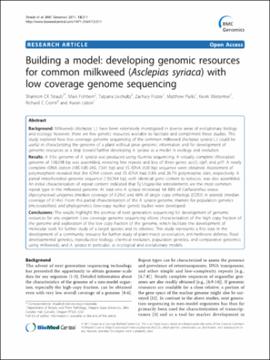| dc.contributor.author | Straub, Shannon C. K. | |
| dc.contributor.author | Fishbein, Mark | |
| dc.contributor.author | Livshultz, Tatyana | |
| dc.contributor.author | Foster, Zachary | |
| dc.contributor.author | Parks, Matthew | |
| dc.contributor.author | Weitemier, Kevin | |
| dc.contributor.author | Cronn, Richard C. | |
| dc.contributor.author | Liston, Aaron | |
| dc.date.accessioned | 2018-11-09T21:10:57Z | |
| dc.date.available | 2018-11-09T21:10:57Z | |
| dc.date.issued | 2011-05-04 | |
| dc.identifier | oksd_straub_buildingamodel_2011-05-04 | |
| dc.identifier.citation | Straub, S. C. K., Fishbein, M., Livshultz, T., Foster, Z., Parks, M., Weitemier, K., ... Liston, A. (2011). Building a model: Developing genomic resources for common milkweed (Asclepias syriaca) with low coverage genome sequencing. BMC Genomics, 12, Article 211. https://doi.org/10.1186/1471-2164-12-211 | |
| dc.identifier.uri | https://hdl.handle.net/11244/302075 | |
| dc.description.abstract | Background: Milkweeds (Asclepias L.) have been extensively investigated in diverse areas of evolutionary biology and ecology; however, there are few genetic resources available to facilitate and compliment these studies. This study explored how low coverage genome sequencing of the common milkweed (Asclepias syriaca L.) could be useful in characterizing the genome of a plant without prior genomic information and for development of genomic resources as a step toward further developing A. syriaca as a model in ecology and evolution. | |
| dc.description.abstract | Results: A 0.5x genome of A. syriaca was produced using Illumina sequencing. A virtually complete chloroplast genome of 158,598 bp was assembled, revealing few repeats and loss of three genes: accD, clpP, and ycf1. A nearly complete rDNA cistron (18S-5.8S-26S; 7,541 bp) and 5S rDNA (120 bp) sequence were obtained. Assessment of polymorphism revealed that the rDNA cistron and 5S rDNA had 0.3% and 26.7% polymorphic sites, respectively. A partial mitochondrial genome sequence (130,764 bp), with identical gene content to tobacco, was also assembled. An initial characterization of repeat content indicated that Ty1/copia-like retroelements are the most common repeat type in the milkweed genome. At least one A. syriaca microread hit 88% of Catharanthus roseus (Apocynaceae) unigenes (median coverage of 0.29x) and 66% of single copy orthologs (COSII) in asterids (median coverage of 0.14x). From this partial characterization of the A. syriaca genome, markers for population genetics (microsatellites) and phylogenetics (low-copy nuclear genes) studies were developed. | |
| dc.description.abstract | Conclusions: The results highlight the promise of next generation sequencing for development of genomic resources for any organism. Low coverage genome sequencing allows characterization of the high copy fraction of the genome and exploration of the low copy fraction of the genome, which facilitate the development of molecular tools for further study of a target species and its relatives. This study represents a first step in the development of a community resource for further study of plant-insect co-evolution, anti-herbivore defense, floral developmental genetics, reproductive biology, chemical evolution, population genetics, and comparative genomics using milkweeds, and A. syriaca in particular, as ecological and evolutionary models. | |
| dc.format | application/pdf | |
| dc.language | en_US | |
| dc.publisher | BioMed Central | |
| dc.rights | This material has been previously published. In the Oklahoma State University Library's institutional repository this version is made available through the open access principles and the terms of agreement/consent between the author(s) and the publisher. The permission policy on the use, reproduction or distribution of the material falls under fair use for educational, scholarship, and research purposes. Contact Digital Resources and Discovery Services at lib-dls@okstate.edu or 405-744-9161 for further information. | |
| dc.title | Building a model: Developing genomic resources for common milkweed (Asclepias syriaca) with low coverage genome sequencing | |
| osu.filename | oksd_straub_buildingamodel_2011-05-04.pdf | |
| dc.description.peerreview | Peer reviewed | |
| dc.identifier.doi | 10.1186/1471-2164-12-211 | |
| dc.description.department | Botany | |
| dc.type.genre | Article | |
| dc.type.material | Text | |
| dc.subject.keywords | mitochondrial genome | |
| dc.subject.keywords | chloroplast genome | |
| dc.subject.keywords | apocynaceae | |
| dc.subject.keywords | organellar genome | |
| dc.subject.keywords | chloroplast genome sequence | |
